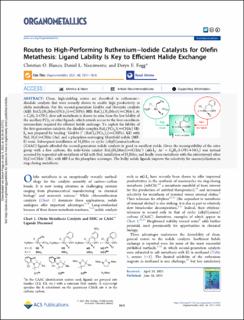| dc.contributor.author | Blanco, Christian O. | |
| dc.contributor.author | Nascimento, Daniel L. | |
| dc.contributor.author | Fogg, Deryn Elizabeth | |
| dc.date.accessioned | 2022-03-29T10:37:57Z | |
| dc.date.available | 2022-03-29T10:37:57Z | |
| dc.date.created | 2021-09-29T14:42:37Z | |
| dc.date.issued | 2021 | |
| dc.identifier.issn | 0276-7333 | |
| dc.identifier.uri | https://hdl.handle.net/11250/2988264 | |
| dc.description.abstract | Clean, high-yielding routes are described to ruthenium–diiodide catalysts that were recently shown to enable high productivity in olefin metathesis. For the second-generation Grubbs and Hoveyda catalysts (GII: RuCl2(H2IMes)(PCy3)(═CHPh); HII: RuCl2(H2IMes)(═CHAr), Ar = C6H4-2-OiPr), slow salt metathesis is shown to arise from the low lability of the ancillary PCy3 or ether ligands, which retards access to the four-coordinate intermediate required for efficient halide exchange. To exploit the lability of the first-generation catalysts, the diiodide complex RuI2(PCy3)(═CHAr) HI-I2 was prepared by treating “Grubbs I” (RuCl2(PCy3)2(═CHPh), GI) with NaI, H2C═CHAr (1a), and a phosphine-scavenging Merrifield iodide (MF-I) resin. Subsequent installation of H2IMes or cyclic (alkyl)(amino)carbene (CAAC) ligands afforded the second-generation iodide catalysts in good to excellent yields. Given the incompatibility of the nitro group with a free carbene, the iodo-Grela catalyst RuI2(H2IMes)(═CHAr′) (nG-I2: Ar′ = C6H3-2-OiPr-4-NO2) was instead accessed by sequential salt metathesis of GI with NaI, installation of H2IMes, and finally cross-metathesis with the nitrostyrenyl ether H2C═CHAr′ (1b), with MF-I as the phosphine scavenger. The bulky iodide ligands improve the selectivity for macrocyclization in ring-closing metathesis. | en_US |
| dc.language.iso | eng | en_US |
| dc.publisher | ACS | en_US |
| dc.relation.uri | https://pubs.acs.org/doi/pdf/10.1021/acs.organomet.1c00253 | |
| dc.rights | Navngivelse 4.0 Internasjonal | * |
| dc.rights.uri | http://creativecommons.org/licenses/by/4.0/deed.no | * |
| dc.title | Routes to High-Performing Ruthenium–Iodide Catalysts for Olefin Metathesis: Ligand Lability Is Key to Efficient Halide Exchange | en_US |
| dc.type | Journal article | en_US |
| dc.type | Peer reviewed | en_US |
| dc.description.version | publishedVersion | en_US |
| dc.rights.holder | Copyright 2021 The Author(s) | en_US |
| cristin.ispublished | true | |
| cristin.fulltext | original | |
| cristin.qualitycode | 2 | |
| dc.identifier.doi | 10.1021/acs.organomet.1c00253 | |
| dc.identifier.cristin | 1940672 | |
| dc.source.journal | Organometallics | en_US |
| dc.source.pagenumber | 1811-1816 | en_US |
| dc.relation.project | Norges forskningsråd: 288135 | en_US |
| dc.identifier.citation | Organometallics. 2021, 40(12), 1811-1816. | en_US |
| dc.source.volume | 40 | en_US |
| dc.source.issue | 12 | en_US |

